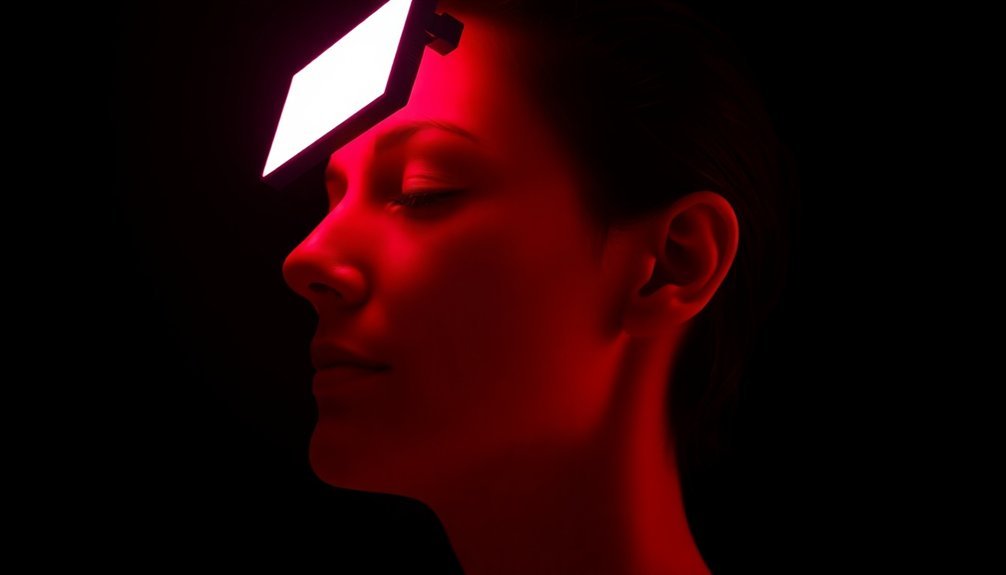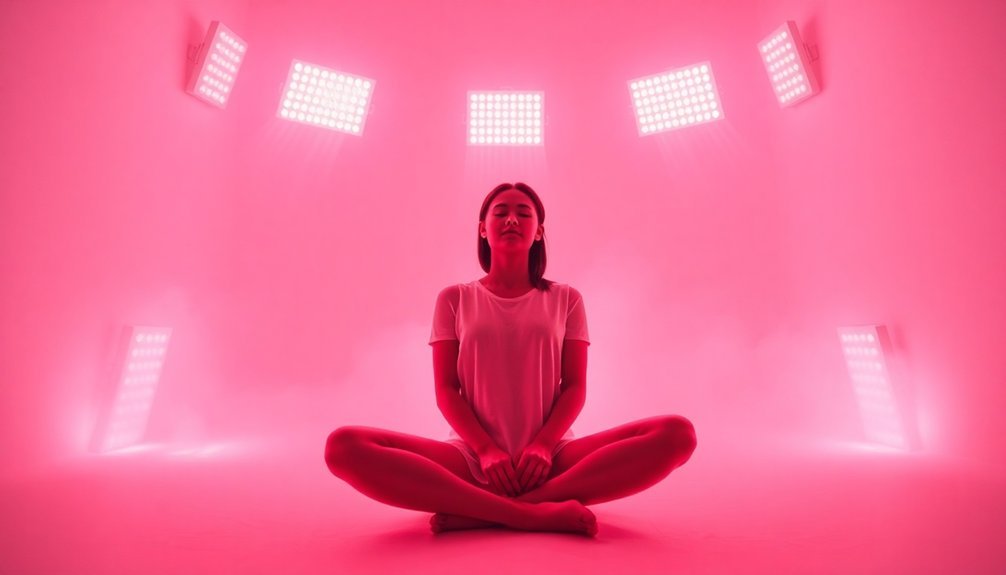Three powerful NIR solutions can substantially boost your mental clarity through proven photobiomodulation mechanisms. You'll achieve excellent results using an 810nm transcranial device aimed directly at your forehead, targeting the prefrontal cortex for enhanced cognition. Alternatively, try intranasal light therapy, which delivers NIR directly to your brain through the nasal cavity. For full coverage, consider a NIR therapy helmet that bathes your entire brain in therapeutic wavelengths. Each method works by stimulating mitochondrial function, increasing blood flow, and promoting neuroplasticity. Discover how these science-backed approaches can transform your cognitive performance.
NIR Light for Brain Enhancement

Three key mechanisms make NIR light therapy a promising tool for brain enhancement. First, it stimulates your brain through photobiomodulation, increasing cerebral blood flow and tissue oxygenation. Studies show that pulsed NIR light at 10Hz achieves 41% better tissue penetration than continuous application.
Second, it promotes the production of brain-derived neurotrophic factor (BDNF), which supports neurological recovery.
Third, it enhances functional connectivity in your brain through non-thermal mechanisms, improving electrophysiological oscillations.
You'll find the most effective results with specific wavelengths, particularly 810 nm, which has shown remarkable success in clinical trials. When used correctly, NIR light therapy can boost your cognitive function and potentially alleviate symptoms of depression. Research, including the NeuroThera Effectiveness and Safety trials, has demonstrated its clinical efficacy in treating acute conditions like stroke.
However, it's essential to understand the limitations. Your skull's thickness (5.9-7.2 mm) can block up to 88.6% of NIR light, requiring higher power outputs and specific wavelengths for effective penetration.
To achieve the best results, you'll need devices that can deliver sufficient fluence to reach target tissues, typically using wavelengths around 808 nm for deeper penetration.
Optimizing Mental Performance With NIR
Building on our understanding of NIR's brain-enhancing mechanisms, you can enhance your mental performance through strategic application of this therapy. By following specific protocols and timing, you'll maximize the benefits of near-infrared light on your cognitive function.
Start with short 3-10 minute sessions, depending on your specific needs and goals. You'll want to maintain consistency while monitoring your response to the treatment. As a complementary approach, NIR therapy can be seamlessly integrated with your existing treatment plans.
NIR therapy works by reducing inflammation in your brain cells, increasing circulation, and activating mitochondria for enhanced cellular energy production.
To boost effectiveness, consider combining NIR with other therapeutic approaches like neurofeedback. This combination can enhance neuroplasticity and improve your brain's adaptability.
If you're using a home device like the Neuronic Neuradiant 1070 Helmet, verify you're following the manufacturer's guidelines for best results.
You'll find NIR particularly beneficial if you're dealing with cognitive challenges, mood issues, or neurological conditions. The therapy's non-invasive nature makes it a safe option for regular use.
While research continues to evolve, current evidence suggests that consistent NIR application can support your brain health and enhance mental performance over time.
Daily NIR Brain Therapy Sessions

A successful NIR brain therapy regimen depends on consistent, properly timed sessions tailored to your needs. You'll typically want to schedule 5-20 minute sessions, 2-3 times per week, though some conditions may require more frequent treatment. If you're using an at-home device, start with 10-minute sessions and gradually increase to 20 minutes if you don't experience side effects. The therapy works by stimulating cellular ATP production to enhance brain function and repair.
| Treatment Goal | Session Length | Weekly Frequency |
|---|---|---|
| General Wellness | 10-15 minutes | 2-3 times |
| Athletic Recovery | 10-20 minutes | Post-exercise |
| ASD Treatment | 40 minutes | Twice daily |
You'll likely notice improvements within 3-5 weeks, with best results typically appearing between 4-8 weeks of consistent use. Regular sessions can enhance your cognitive function, improve sleep quality, and reduce symptoms of conditions like PTSD. During winter months, you might benefit from increased session frequency due to reduced natural light exposure. For sustainable results, consider implementing maintenance sessions after achieving your initial therapeutic goals. Remember to consult a healthcare professional to develop a personalized treatment plan that aligns with your specific needs and conditions.
Frequently Asked Questions
Can NIR Therapy Interact Negatively With Psychiatric Medications?
Yes, NIR therapy can interact with psychiatric medications. You should always consult your doctor before starting treatment, as certain medications like lithium can increase photosensitivity and may cause adverse reactions.
What Age Is Too Young to Start Using NIR for Brain Health?
You shouldn't start NIR therapy for brain health in children under 18 without medical supervision. While it's generally safe for adults, there's limited research on younger populations, so consult a healthcare provider first.
Are There Any Long-Term Risks Associated With Daily NIR Exposure?
Yes, you'll face risks with daily NIR exposure including accelerated skin aging, increased cataract formation, and potential DNA damage. Long-term exposure can generate harmful reactive oxygen species and suppress your body's natural cell death mechanisms.
How Does NIR Compare to Traditional Light Therapy for Seasonal Depression?
You'll find both NIR and traditional light therapy effectively treat seasonal depression. NIR penetrates deeper and offers additional benefits like pain relief, while both improve mood by regulating circadian rhythms and boosting serotonin production.
Can NIR Therapy Help With Recovery From Long-Term Substance Abuse?
Yes, NIR therapy can help your substance abuse recovery by reducing withdrawal symptoms, boosting mood, and improving sleep. It works with your body's natural healing processes while supporting mental health and reducing cravings.
In Summary
You'll find near-infrared light therapy offers a natural, non-invasive way to boost your mental clarity and cognitive function. Start with short daily sessions, gradually increase exposure time, and combine NIR with other healthy brain habits. Whether you choose a professional NIR device or a quality home unit, consistent use will help optimize your mental performance. Make NIR therapy part of your daily wellness routine for lasting results.





Leave a Reply